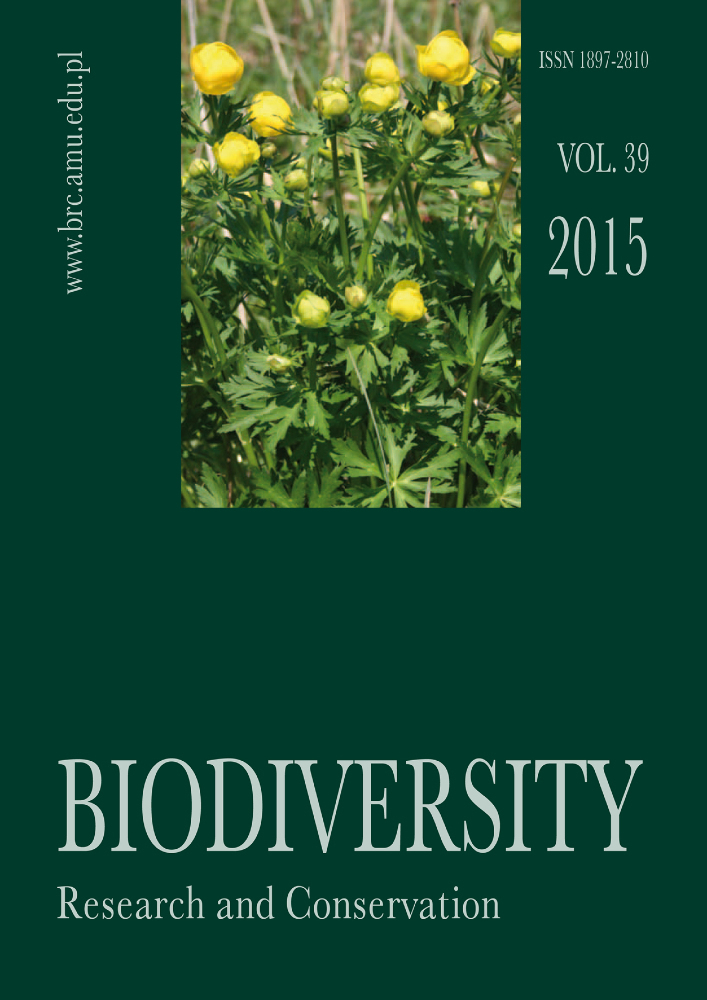Abstract
Calypogeia fissa is a suboceanic-mediterrean and amphiatlantic species, which comprises two subspecies: C. fissa subsp. fissa occurring in Europe and C. fissa subsp. neogea Schust. known from North America. Recently, within the European part of distribution, three groups (PS, PB and G) were distinguished with the aid of genetic and molecular markers. The flow cytometry results revealed that two of the detected groups of the European C. fissa, which are frequent in Poland (PS and PB), differ in ploidy level: the PS group is haploid, whereas the PB group is diploid. Isozyme pattern at two loci may suggest an allopolyploid origin of the diploid PB group.
References
Boisselier-Dubayle M. C. & Bischler H. 1998. Allopolyploidy in the thalloid liverwort Corsinia (Marchantiales). Bot. Acta 111: 490-496.
Boisselier-Dubayle M. C., Lambourdiere J. & Bischler H. 1998a. The leafy liverwort Porella baueri (Porellaceae) is an allopolyploid. Pl. Syst. Evol. 210: 175-197.
Boisselier-Dubayle M. C., Lambourdiere J. & Bischler H. 1998b. Taxa delimitation in Reboulia investigated with morphological, cytological, and isozyme markers. Bryologist 101: 61-69.
Buczkowska K. 2004. Genetic differentiation of Calypogeia fissa (L.) Raddi (Hepaticae, Jungermanniales) in Poland. Pl. Syst. Evol. 247: 187-201.
Buczkowska K., Odrzykoski I. J. & Chudzińska E. 2004. Delimitation of some European species of CalypogeiaRaddi (Hepaticae Jungermnniales) based on cytological characters of oil bodies and multienzyme phenotype. Nova Hedwigia 78: 147-163.
Buczkowska K. & Bączkiewicz A. 2011. New taxon of the genus Calypogeia (Jungermanniales, Hepaticae) in Poland. Acta Soc. Bot. Pol. 80: 327-333.
Buczkowska K., Sawicki J., Szczecińska M., Klama H. & Bączkiewicz A. 2012a. Allopoliploid speciation of Calypogeia sphagnicola (Jungermanniopsiada, Calypogeiaceae) based on isozyme and DNA markers. Pl. Syst. Evol. 298: 549-560.
Buczkowska K., Gonera P. & Hornik B. 2012b. PCR-based molecular markers for identyfication of taxa from the Calypogeia fissa complex (Jungermanniopsida, Calypogeiaceae). Biodiv. Res. Conserv. 28: 9-18.
Buczkowska K., Sawicki J., Szczecińska M., Rosadziński S., Rabska M. & Bączkiewicz A. 2011. Two morphologically distinct groups of the Calypogeia fissa complex were found in Europe. Biodiv. Res. Conserv. 23: 7-19.
Chudzińska E., Barczak H. & Szweykowski J. 2001. Chromosome numbers in some Polish critical or rare Liverworts (Hepaticae). Cryptogamie, Bryol. 22(2): 85-93.
Damsholt K. 2002. Illustrated Flora of Nordic Liverworts and Hornworts. 840 pp. Nordic Bryological Society, Lund.
Fiedorow P., Odrzykoski I. J., Szweykowski J. & Szweykowska-Kulińska Z. 2001. Phylogeny of the European species of the genus Pellia (Hepaticae, Metzgeriales) based on the molecular data from nuclear tRNALeu (CAA) intergenic sequences. Gene 262: 309-315.
Fritch R. 1991. Index to bryophyte chromosome counts. Bryoph. Bibl. 40: 19-20.
Inoue H. 1976. Chromosome studies in some Arctic hepatics. Bull. Nat. Sci. Mus. Tokyo Ser. B 2: 39-46.
Jankowiak-Siuda K., Pacak A., Odrzykoski I., Wyatt R. & Szweykowska-Kulińska Z. 2008. Organellar inheritance in the allopolyploid moss Plagiomnium curvatulum. Taxon 57: 137-143.
Jankowiak K., Rybarczyk A., Wyatt R., Odrzykoski I., PacakA. & Szweykowska-Kulinska Z. 2005. Organellar inheritance in the allopolyploid moss Rhizomnium pseudopunctatum, Taxon 54: 383-388.
Lorbeer G. 1934. Zytologie der Lebermoose mit besonderer Berücksichtigung allgemeiner Chromosomenfragen. I. Teil. Jahrb. Wiss. Bot. 80: 567-818.
Müller K. 1951-1958. Die Lebermoose Europas In: Dr L. Rabenhorst’s Kryptogamen Flora von Deutschland Österreich und der Schweiz. 3rd ed. Akademische Verlagsgesellaschaft Geest & Portig K.-G., Leipzig.
Newton M. 1973. Chromosome studies in some British and Irish bryophytes, II. J. Bryol 7:379-398.
Odrzykoski I. J., Chudzińska E. & Szweykowski J. 1996. The hybrid origin of the polyploid liverwort Pellia borealis. Genetica 98: 75-86
Paton J. 1999. The Livervort Flora of the British Isles. Harley Books, Colchester.
Ricca M., Beecher F. W., Boles S. B., Temsch E., Greilhuber J., Karlin E. F. & Shaw A. J. 2008. Cytotype variation and allopolyploidy in North American species of the Sphagnum subsecundum complex (Sphagneceae). Am. J. Bot. 95: 1606-1620.
Såstad S. M. 2005. Patterns and mechanisms of polyploid formation in bryophytes. Regnum Vegetabile 143: 317-334.
Schuster R. M. 1969. The Hepaticae and Anthocerotae of North America east of the hundredth meridian vol 2, Columbia University Press, New York-London.
Shaw A. J. 2001. Biogeographic patterns and cryptic speciation in bryophytes. J. Biogeog. 28: 253-261.
Šmarda P. 2006. DNA ploidy levels and intraspecific DNA content variability in Romanian fescues (Festuca, Poaceae) measured in fresh and herbarium material. Folia Geobot. 41: 417-432.
Szweykowski J. 2006. An annotated checklist of Polish liverworts. In: Z. Mirek (ed.) Biodiversity of Poland, 4, 114 pp. W. Szafer Institute of Botany, Polish Academy of Sciences, Kraków.
Śliwińska E., Krzakowa M. & Melosik I. 2000. Estimation of ploidy level in four Sphagnum species (Subsecunda section) by flow cytometry. In: M. Krzakowa & I. Melosik (eds.). The variability in Polish populations of sphagnum taxa (Subsecunda section) according to morphological anatomical and biochemical traits. Bogucki Press SC, Poznań, pp. 137-150.
Temsch E., Greilhuber J. & Krisai R. 2010. Genome size in liverworts. Preslia 82: 63-80.
Wendel J. E. & Weeden N. F. 1989. Visualisation and interpretation of plant isozymes. In: D. E. Soltis & P. S . Soltis (eds.). Isozymes in Plant Biology, pp. 4-45. Dioscorides Press, Portland, Oregon.




